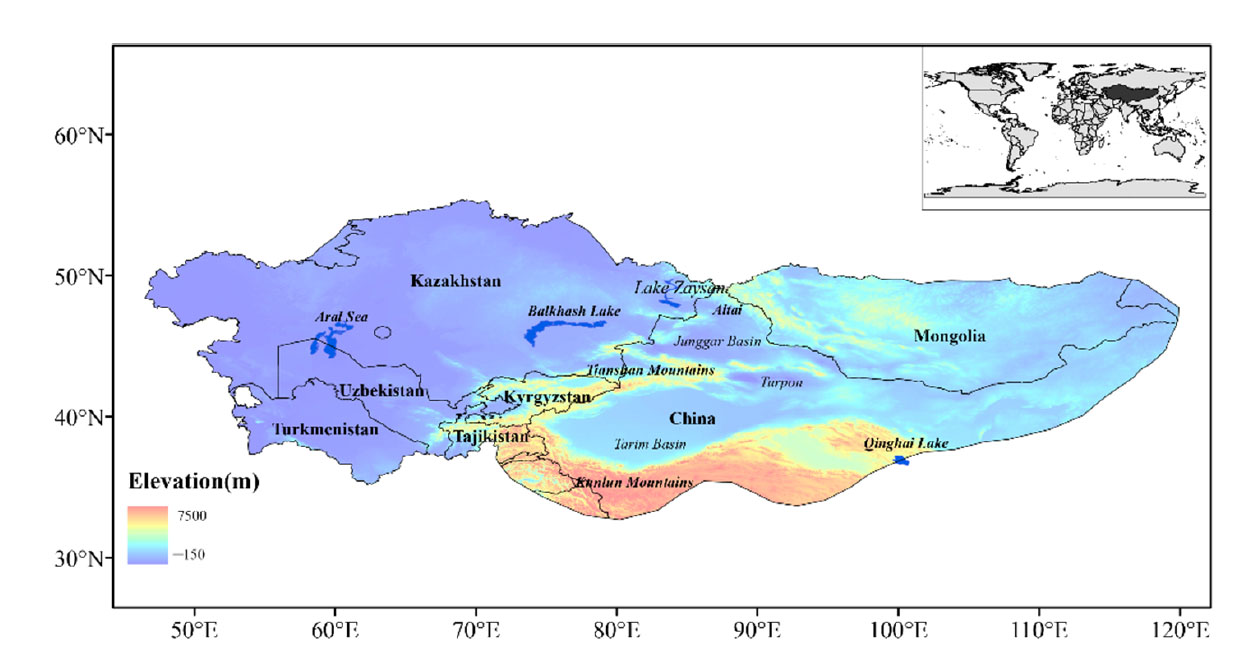In recent years, the warming–wetting trend
in the arid region of Northwest China has attracted widespread attention. Associate
editor-in-chief Zhang Qiang and his team recently published an article on
Atmosphere entitled " Climatic Change Characteristics towards the ‘Warming–Wetting’
Trend in the Pan-Central-Asia Arid Region" to reveal whether this
phenomenon exists in the whole Pan-Central-Asia arid region, this paper adopts
the latest monthly gridded dataset of the Climate Research Unit Time Series
version 4.05 (CRU TS v4.05) and the multi-model ensemble data of the Coupled
Model Inter-comparison Project Phase 6 (CIMP6) for discussion from multiple
perspectives.

(The Pan-Central-Asia arid region)
The results show that:
In the last 80 years, the warming rate in the Pan-Central-Asia arid region was 0.26 °C/10a, which is higher than the global average in the same period (0.18 °C/10a). After 2000, the temperature growth rate decreased to 0.11 °C/10a, similar to the global warming stagnation. Nevertheless, the PET increment in the same period (19.18 mm/10a) was much higher than the average growth rate in the last 80 years. Since the turn of the 21st century, although the growth rate of precipitation has been higher than the average in the last 80 years, the rate of Aridity Index (AI) has decreased to -0.004/10a. It shows that the regional wetting trend is slowing down, mainly due to the leap growth of PET caused by global warming.
The interannual time scale dominated the precipitation change in the last 80 years, including quasi-three-year cycle and quasi-six-year cycle, of which the former is more significant. However, the decadal and multi-decadal changes were weak. The interannual cycle of precipitation was mainly affected by the change in PDO phases. The long-term trend dominated the main variation characteristics of temperature and was significantly related to the variations in AO. In addition, the interannual variation in temperature in the quasi-three-year cycle was also significant, while the interannual and multi-decadal scale changes were relatively weak. In a word, future research and prediction of precipitation in the Pan-Central-Asia arid region should focus on PDO variations, followed by SOI variations. For the research and prediction of temperature, the variations in AO are impossible to overlook.
In the last 80 years, except for a few regions in central-eastern Mongolia and central Kazakhstan, the precipitation in most parts of the Pan-Central-Asia arid region has increased. The centers of precipitation variation were located in Xinjiang, Western Uzbekistan, Northern Kazakhstan and most of the Pamirs Plateau. The regional temperature was mainly increasing, but in the northeast slope of Qinghai–Tibet Plateau and Hexi Corridor, the temperature increment was obviously lower than that in other regions. There was a stepwise decrease in regional temperature from northwest to southeast.
There has been a noticeable wetting trend in most parts of the Pan-Central-Asia arid region, with the wetting centers in central-northern Kazakhstan and northern Xinjiang. Besides, southern Kazakhstan, most of Mongolia, and the Inner Mongolia Plateau show a drying trend. Since the turn of the 21st century, there has been a pattern of “water-logging in the middle and drought in the surrounding areas” in Xinjiang, and most local AI has shown a positive variation trend. However, it does not affect the overall warming and wetting in Northwest China.
The increase in precipitation alleviates the drought process in most of the study regions, including most of Northwest China. Moreover, with the steady temperature rise, these regions become wetter and warmer. However, the “warming-wetting” trend is not equal to “humid climate”. Under climate warming background, extreme precipitation increases, and the distribution is highly uneven. Besides, because the increase in PET offsets most of the increase in precipitation, the arid and semi-arid climate pattern in the arid region of Pan-Central-Asia has not changed.
The climate in the Pan-Central-Asia arid region has changed towards the warming–wetting trend in the last 80 years. The trend could accelerate obviously in the next 80 years in medium-emissions scenarios. According to the forecast results, the regional average temperature will reach about 8.5 °C, significantly higher than that in 2010 (5.7 °C) by the end of this century. The sharp rise in precipitation may result in highly non-uniform precipitation distribution, which means more extreme weather may occur. Although the increase in precipitation may be a positive aspect of this trend, the rise in PET caused by sharp warming may cause greater challenges to the regional climate and ecological environment. Nevertheless, the estimated results are subject to considerable uncertainty, and the comprehensive impacts of elevated temperature and variable precipitation on drought are still unknown. Considering the significant impact of climate change on ecosystems, solving the uncertainty of model predictions should remain a focus of climate modeling in the future.
DOWNLOAD: /attached/file/20220320/20220320155237_467.pdf
Citation:Yan, X.; Zhang, Q.; Ren, X.; Wang, X.; Yan, X.; Li, X.;Wang, L.; Bao, L. Climatic Change Characteristics towards the “Warming–Wetting” Trend in the Pan-Central-Asia Arid Region[J]. Atmosphere, 2022, 13, 467. https://doi.org/10.3390/atmos13030467


